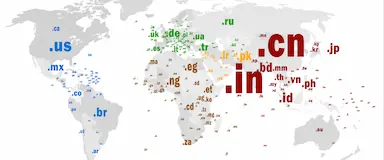With generic TLDs being oversaturated and marketed globally, country domains can help you reach a local audience and boost SEO.
The Ultimate Guide to .eu Domain Names
Written by Steven White ·

When you look at the list of the top 10 European country code top-level domains, or ccTLDs for short, you’ll find some expected heavyweights – .de for Germany, .uk for the United Kingdom, and .fr for France. However, you’ll also notice that this top 10 list contains a unique ccTLD – the only one that isn’t associated with a single country.
The domain in question is .eu.
According to the Global Domain Report 2024, the .eu ccTLD accounts for as many as 3.7 million domain registrations in 2024, placing it within the top five of the most used domains in Europe. But what makes this ccTLD – that isn’t even a ccTLD in the traditional sense of the word – so popular? That’s just one of the questions this ultimate guide on .eu domain names will answer.
What Is the .eu Domain?
As you probably already know, “EU” stands for “European Union,” a political and economic alliance of 27 predominantly European member states. And that’s precisely who the .eu domain was created to cater to – individuals, businesses, and organizations within the European Union.
Interestingly, it took as many as five years for the European Union Commission and the Internet Corporation for Assigned Names and Numbers (the organization responsible for managing global domain names and IP addresses) to finalize and implement the .eu domain. This day finally came on December 7, 2005, as this domain went live.
It took about nine years for this domain to also become available to individuals, businesses, and organizations across the European Economic Area, which includes additional countries beyond the EU. The countries in question are three of the four European Free Trade Association member states – Iceland, Lichtenstein, and Norway.
Why Is the .eu Domain So Popular?
The EU is all about fostering unity and collaboration among its member states, and the .eu domain mirrors this ethos in the digital realm. As such, the popularity of this ccTLD can be attributed to several factors.
Adopting the Highly Desirable European Identity
The EU reigns supreme when it comes to a unified European identity. European countries that aren’t EU members go to great lengths to become part of this shared identity and – let’s face it – market. By adopting this highly desirable domain, you send a clear message to your website visitors – you’re in with the right crowd.
Establishing Unprecedented Market Reach
Let’s say you’re doing business across multiple European countries. Getting tied down to a single national domain – even if it’s a popular choice like .nl – can be quite limiting and cumbersome. The .eu domain, on the other hand, offers the pan-European market presence you’re so eager to achieve.
Nurturing Trust and Credibility
The EU is synonymous with high standards and regulatory rigor. Obtain a .eu domain name, and that’s precisely the message your website will convey. The result? A boost in your credibility and trustworthiness in the eyes of European consumers.
Who Can Register a .eu Domain?
EURid, the registry manager of the .eu domain names, only has one requirement – the registrant must have a connection to the European Union (or the European Economic Area). This means that you either must be from the European Union, Iceland, Liechtenstein, and Norway or your business must be established there.
Don’t meet this requirement? Don’t worry! You can still try to secure a .eu domain through a trustee service. In short, this service designates a local representative to hold the domain on your behalf. This is also the only way for the residents of the U.K. and Gibraltar to hold a .eu domain, as these regions are no longer part of the EU.
All registrants must also comply with EU regulations and policies, as well as register for the .eu extension for a minimum of one year.
How to Get a .eu Domain
Do you meet the specific criteria necessary to purchase a .eu domain name? If so, perfect! Only a few steps separate you from securing this coveted ccTLD. The steps in question include finding a reliable domain register, choosing an available domain name, and following the on-screen instructions to complete the registration process. And just like that – after the verification process is complete – you’ll become a proud owner of a .eu domain!



